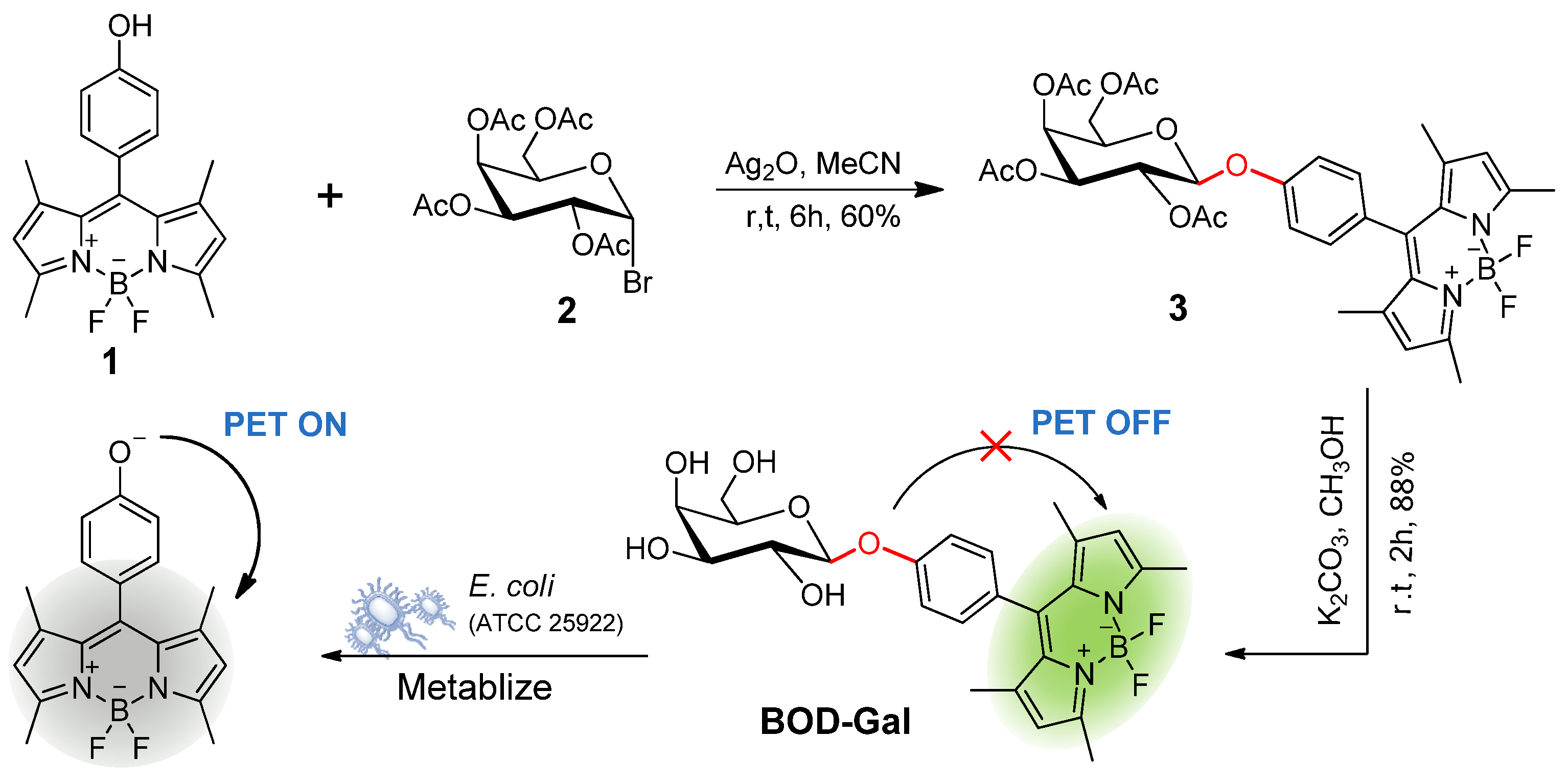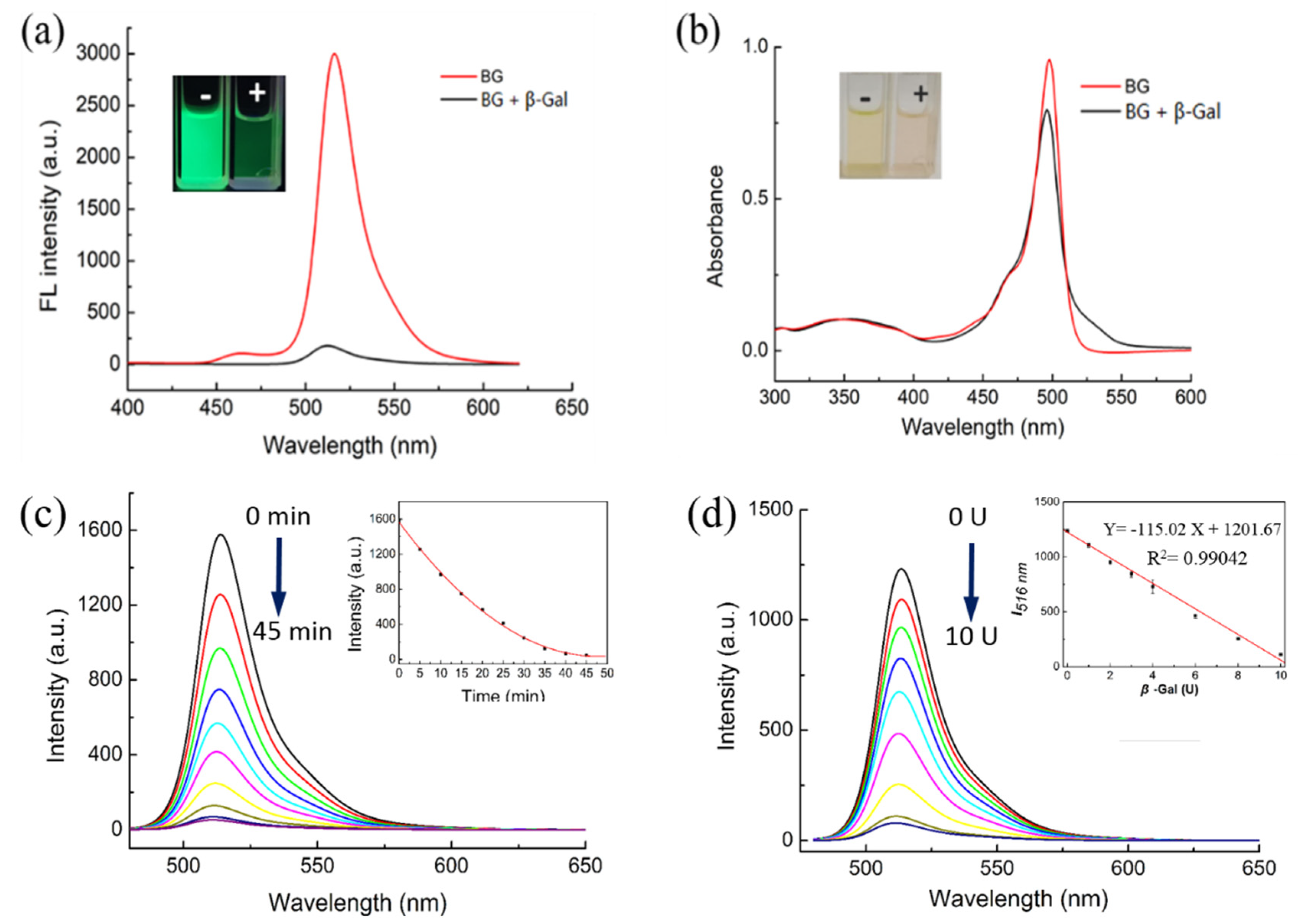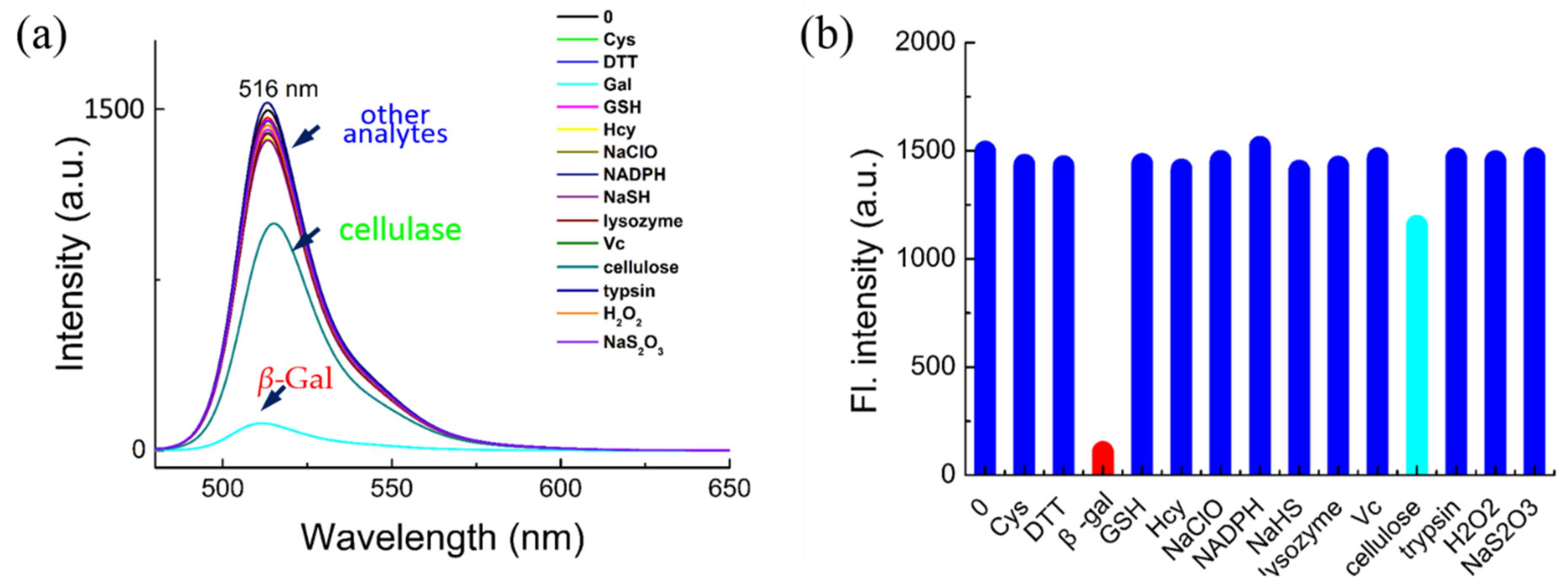A Galactosidase-Activatable Fluorescent Probe for Detection of Bacteria Based on BODIPY
Abstract
:1. Introduction
2. Results
2.1. In Vitro Spectrum Study
2.2. Kinetics Studies of Enzymatic Reaction
2.3. Theoretical Calculations
2.4. Biological Activity
2.4.1. Biological Toxicity to Bacterial Propagation
2.4.2. Fluorescence on Agar
3. Materials and Methods
3.1. General Information
3.2. Enzyme Assay In Vitro
3.3. HPLC Analysis
3.4. Biological Experiment
3.4.1. The Culture of Bacteria
3.4.2. Preparation of Culture Media
3.4.3. Antibacterial Evaluation
3.5. Synthesis
3.5.1. Synthesis of Compound 1
3.5.2. Synthesis of Compound 3
3.5.3. Synthesis of BOD-Gal
4. Conclusions
Supplementary Materials
Author Contributions
Funding
Institutional Review Board Statement
Informed Consent Statement
Data Availability Statement
Acknowledgments
Conflicts of Interest
Sample Availability
References
- Todd, E.C.D. Epidemiology of food borne diseases: A worldwide review. World Health Stat. Q. 1997, 50, 30–50. Available online: https://www.who.int/iris/handle/10665/54782 (accessed on 20 August 2021).
- Altekruse, S.F.; Swerdlow, D.L. The Changing Epidemiology of Foodborne Diseases. Am. J. Med. Sci. 1996, 311, 23–29. [Google Scholar] [CrossRef]
- Yang, S.C.; Lin, C.H.; Aljuffali, I.A.; Fang, J.Y. Current pathogenic Escherichia coli foodborne outbreak cases and therapy development. Arch. Microbiol. 2017, 199, 811–825. [Google Scholar] [CrossRef]
- Velusamy, V.; Arshak, K.; Korostynska, O.; Oliwa, K.; Adley, C. An overview of foodborne pathogen detection: In the perspective of biosensors. Biotechnol. Adv. 2010, 28, 232–254. [Google Scholar] [CrossRef]
- Perry, J.D. A Decade of Development of Chromogenic Culture Media for Clinical Microbiology in an Era of Molecular Diagnostics. Clin. Microbiol. Rev. 2017, 30, 449–479. [Google Scholar] [CrossRef] [Green Version]
- Manafi, M. New developments in chromogenic and fluorogenic culture media. Int. J. Food Microbiol. 2000, 60, 205–218. [Google Scholar] [CrossRef]
- Varadi, L.; Gray, M.; Groundwater, P.W.; Hall, A.J.; James, A.L.; Orenga, S.; Perry, J.D.; Anderson, R.J. Synthesis and evaluation of fluorogenic 2-amino-1,8-naphthyridine derivatives for the detection of bacteria. Org. Biomol. Chem. 2012, 10, 2578–2589. [Google Scholar] [CrossRef]
- Perry, J.D.; James, A.L.; Morris, K.A.; Oliver, M.; Chilvers, K.F.; Reed, R.H.; Gould, F.K. Evaluation of novel fluorogenic substrates for the detection of glycosidases in Escherichia coli and enterococci. J. Appl. Microbiol. 2006, 101, 977–985. [Google Scholar] [CrossRef] [PubMed]
- Geissler, K.; Amoro’s, M.M.; Alonso, J.L. Quantitative determination of total coliforms and Escherichia coli in marine waters with chromogenic and fluorogenic media. J. Appl. Microbiol. 2000, 88, 280–285. [Google Scholar] [CrossRef] [Green Version]
- Perry, J.D.; Morris, K.A.; James, A.L.; Oliver, M.; Gould, F.K. Evaluation of novel chromogenic substrates for the detection of bacterial beta-glucosidase. J. Appl. Microbiol. 2007, 102, 410–415. [Google Scholar] [CrossRef] [PubMed]
- Feng, P.C.S.; Hartman, P.A. Fluorogenic Assays for Immediate Confirmation of Escherichia coli. Appl. Environ. Microbiol. 1982, 43, 1320–1329. [Google Scholar] [CrossRef] [Green Version]
- Martinez, C.R.; Rodriguez, T.L.; Zhurbenko, R.; Valdes, I.A.; Gontijo, S.M.; Gomes, A.D.; Suarez, D.F.; Sinisterra, R.D.; Cortes, M.E. Development of a calcium phosphate nanocomposite for fast fluorogenic detection of bacteria. Molecules 2014, 19, 13948–13964. [Google Scholar] [CrossRef] [Green Version]
- Mihalcescu, I.; Van-Melle Gateau, M.; Chelli, B.; Pinel, C.; Ravanat, J.L. Green autofluorescence, a double edged monitoring tool for bacterial growth and activity in micro-plates. Phys. Biol. 2015, 12, 066016. [Google Scholar] [CrossRef]
- Guilini, C.; Baehr, C.; Schaeffer, E.; Gizzi, P.; Rufi, F.; Haiech, J.; Weiss, E.; Bonnet, D.; Galzi, J.L. New fluorescein precursors for live bacteria detection. Anal. Chem. 2015, 87, 8858–8866. [Google Scholar] [CrossRef]
- Wang, T.; Douglass, E.F., Jr.; Fitzgerald, K.J.; Spiegel, D.A. A “turn-on” fluorescent sensor for methylglyoxal. J. Am. Chem. Soc. 2013, 135, 12429–12433. [Google Scholar] [CrossRef]
- Ucuncu, M.; Emrullahoglu, M. A BODIPY-based reactive probe for the detection of Au(III) species and its application to cell imaging. Chem. Commun. 2014, 50, 5884–5886. [Google Scholar] [CrossRef] [PubMed] [Green Version]
- Ulrich, G.; Ziessel, R.; Harriman, A. The Chemistry of Fluorescent Bodipy Dyes: Versatility Unsurpassed. Angew. Chem. Int. Ed. 2008, 47, 1184–1201. [Google Scholar] [CrossRef] [PubMed]
- Bozdemir, O.A.; Sozmen, F.; Buyukcakir, O.; Guliyev, R.; Cakmak, Y.; Akkaya, E.U. Reaction-Based Sensing of Fluoride Ions Using Built-In Triggers for Intramolecular Charge Transfer and Photoinduced Electron Transfer. Org. Lett. 2010, 12, 1400–1403. [Google Scholar] [CrossRef] [PubMed]
- Gu, K.; Xu, Y.; Li, H.; Guo, Z.; Zhu, S.; Shi, P.; James, T.D.; Tian, H.; Zhu, W.H. Real-Time Tracking and In Vivo Visualization of β-Galactosidase Activity in Colorectal Tumor with a Ratiometric NIR Fluorescent Probe. J. Am. Chem. Soc. 2016, 138, 5334–5340. [Google Scholar] [CrossRef] [Green Version]
- Bai, T.; Chu, T. Exploring the Simultaneous Biothiols-differentiating Detecting Feature of a BODIPY Chemosensor with DFT/TDDFT. J. Mol. Liq. 2020, 309, 113145. [Google Scholar] [CrossRef]
- Ueno, T.; Urano, Y.; Kojima, H.; Nagano, T. Mechanism-based molecular design of highly selective fluorescence probes for nitrative stress. J. Am. Chem. Soc. 2006, 128, 10640–10641. [Google Scholar] [CrossRef]
- Wang, X.; Bai, T.; Chu, T. A molecular design for a turn-off NIR fluoride chemosensor. J. Mol. Model. 2021, 27, 104. [Google Scholar] [CrossRef]
- Jiao, L.; Yu, C.; Li, J.; Wang, Z.; Wu, M.; Hao, E. Beta-formyl-BODIPYs from the Vilsmeier-Haack reaction. J. Org. Chem. 2009, 74, 7525–7528. [Google Scholar] [CrossRef] [PubMed]
- Tian, J.; Ouyang, W.; He, Y.; Ning, Q.; Bai, J.; Ding, H.; Xiao, Q. Practical Synthesis of the Fluorogenic Enzyme Substrate 4-Methylumbelliferyl α-l-Idopyranosiduronic Acid. Synlett 2020, 31, 1083–1086. [Google Scholar] [CrossRef]






Publisher’s Note: MDPI stays neutral with regard to jurisdictional claims in published maps and institutional affiliations. |
© 2021 by the authors. Licensee MDPI, Basel, Switzerland. This article is an open access article distributed under the terms and conditions of the Creative Commons Attribution (CC BY) license (https://creativecommons.org/licenses/by/4.0/).
Share and Cite
Chen, X.; Liu, Y.-C.; Cui, J.-J.; Wu, F.-Y.; Xiao, Q. A Galactosidase-Activatable Fluorescent Probe for Detection of Bacteria Based on BODIPY. Molecules 2021, 26, 6072. https://doi.org/10.3390/molecules26196072
Chen X, Liu Y-C, Cui J-J, Wu F-Y, Xiao Q. A Galactosidase-Activatable Fluorescent Probe for Detection of Bacteria Based on BODIPY. Molecules. 2021; 26(19):6072. https://doi.org/10.3390/molecules26196072
Chicago/Turabian StyleChen, Xi, Yu-Cong Liu, Jing-Jing Cui, Fang-Ying Wu, and Qiang Xiao. 2021. "A Galactosidase-Activatable Fluorescent Probe for Detection of Bacteria Based on BODIPY" Molecules 26, no. 19: 6072. https://doi.org/10.3390/molecules26196072
APA StyleChen, X., Liu, Y.-C., Cui, J.-J., Wu, F.-Y., & Xiao, Q. (2021). A Galactosidase-Activatable Fluorescent Probe for Detection of Bacteria Based on BODIPY. Molecules, 26(19), 6072. https://doi.org/10.3390/molecules26196072





